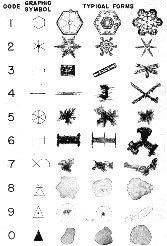
Snow Crystal Classifications
There are a few different schemes for classifying natural snow crystals and
other types of frozen precipitation. The classifications all distinguish between
the basic plate-like and columnar crystal morphologies, but differ in the number
of categories and other details. The categories are all arbitrary to some degree,
but are useful for defining a common language with which to describe snow crystal
observations. The classification schemes also provide a convenient "field
guide" when observing natural snowfalls.

International Commission
on Snow and Ice
A fairly simple and widely used classification for solid precipitation is that
proposed in 1951 by the International Commission on Snow and Ice. This scheme
defines the seven principal snow crystal types as plates, stellar crystals,
columns, needles, spatial dendrites, capped columns, and irregular forms. To
these are added three additional types of frozen precipitation: graupel, ice
pellets, and hail.
Nakaya's Classification
Nakaya identified seven major groupings of snow crystals, which subdivide further
into 41 individual morphological types.
Magono and Lee
The most complex classification scheme is an extension of Nakaya's table, published
by Magono and Lee in 1966. A few of the 80 separate morphological types are
shown at the left, and the full version can be seen by clicking on the image.
An inspection of all the entries in this table gives one a good feel for the
full range of snow crystal precipitation.